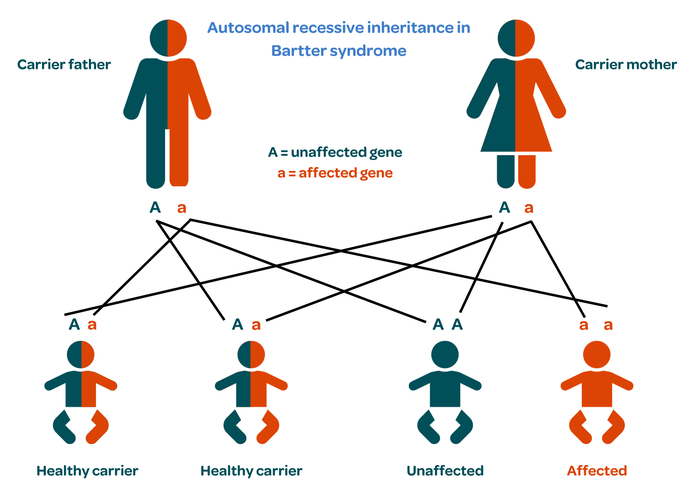What is Bartter syndrome?
Bartter syndrome (also known as salt wasting nephropathy) is a very rare type of inherited kidney condition that cause excess salt and water to be lost from the body in the urine. Five different types of Bartter syndrome have been identified so far, known as Bartter types 1 to 5.
Bartter syndrome type 3 is similar to Gitelman syndrome and is covered on that page.
Bartter syndrome is named after the doctor who first identified the condition in 1960, Dr Frederic Bartter.
Combined, Bartter syndrome types 1, 2, 4 and 5 affect around 1 in 1,000,000 people in the UK. It is usually first diagnosed in childhood. Men and women are affected equally.
What are the signs and symptoms of Bartter syndrome?
The specific symptoms of Bartter syndrome, their severity and the age at which they first appear can vary, even between people with the same subtype.
Bartter syndrome can cause symptoms before birth as there may be an excess of amniotic fluid surrounding the developing baby in the womb. This can often lead to a premature delivery.
After birth, common symptoms of Bartter syndrome include:
- repeated vomiting
- muscle weakness
- muscle spasms
- cramp
- persistent thirst
- frequent need to urinate
- reduced growth
- low blood pressure
- persistent tiredness
- a craving for salt
- general failure to thrive in children
Bartter syndrome type 4 may also result in mild hearing loss.
Illnesses such as the flu or diarrhoea can be very serious for people with Bartter syndrome, as they can quickly become dehydrated and may require hospitalisation to receive fluids by a drip.
What causes Bartter syndrome?
Bartter syndrome is caused by changes in one or more of the genes that control how the kidneys absorb and process salt. Mutations in these genes cause the body to lose too much salt in the urine.
| Bartter type | Gene affected |
|---|---|
| Type 1 | SLC12A1 |
| Type 2 | KCNJ1 |
| Type 3 (Gitelman syndrome) | CLCNKB |
| Type 4 | BSND, CLCNKA and CLCNKB |
| Type 5 | MAGED2 |
/about-us/kidney-care-uk-is-pif-tick-accredited/These genes affect part of the kidney called the loop of Henle, which is responsible for filtering the blood and reabsorbing nutrients such as salt and potassium.
When these genes do not work properly, salt and potassium are lost in the urine instead of being reabsorbed into the blood.
How is Bartter syndrome diagnosed?
Bartter syndrome is usually diagnosed by a blood test that shows low levels of potassium and high levels of bicarbonate. This is known as hypokalaemic alkalosis. A urine electrolyte test will also show high levels of sodium, potassium and chloride.
Genetic testing may also be possible, especially if there is a family history of Bartter syndrome or other kidney disease.
Does Bartter syndrome affect other parts of the body?
Bartter syndrome itself only affects the kidneys but symptoms can include muscle weakness and general reduced growth.
Bartter syndrome can alter the effects of anaesthetics. People with Bartter syndrome should therefore tell their doctors and dentists about their diagnosis, even if the treatment they are having is not related to their condition (for example, a local anaesthetic to remove a tooth).
Does Bartter syndrome run in families?
Bartter syndrome is a genetic condition so it can be passed on from one generation to the next. In the majority of cases, this occurs through an inheritance pattern called autosomal recessive inheritance.
Everybody has two copies of the genes involved in Bartter syndrome, one from each parent.
Healthy people have two normal copies.
Carriers have one copy that works normally and one that doesn’t. Carriers are usually healthy because the normal copy can still do its job. However, they can still pass Bartter syndrome on to their child. The chance of someone in the general population being a carrier is less than 1 in 100 (less than 1 in 1,000 for type 4). In family members of people with Bartter syndrome, the chance of being a carrier is higher.
In people with Bartter syndrome, neither copy of the gene works properly, causing the kidneys to leak salt and water into the urine.
When both parents are carriers, a child could be healthy with two normal genes; a healthy carrier like their parents, with one healthy and one faulty gene; or affected, with both genes being faulty. This pattern is called autosomal recessive inheritance.

How is Bartter syndrome treated?
Treatment focuses on ‘topping up’ the levels of salts through dietary changes and potassium supplements. It is rarely possible to normalise the potassium levels but increasing them helps to improve symptoms.
People with Bartter syndrome are likely to be advised to follow a special diet that is high in salt and potassium. This should only be undertaken with advice and monitoring by a specialised kidney dietitian.
High doses of potassium supplements may be needed, which can be difficult to digest and can cause side effects such as abdominal pain and diarrhoea. Liquid supplements tend to cause fewer side effects than tablets.
During periods when the body is under stress, such as during illness or after surgical procedures, salt levels can change very quickly. This may result in the need for intravenous (IV) therapy in hospital to quickly top up salt levels.
Non-steroidal medications such as indomethacin may also be prescribed to help the kidneys hold on to the potassium and water that the body needs. Potassium-sparing diuretics may also be prescribed. These medications increase the amount of fluid that leaves the body in the urine, while retaining the potassium that would normally also be lost.
Hearing aids may be recommended for people with Bartter type 4, although hearing loss cannot be reversed.
Bartter syndrome requires lifelong monitoring and treatment. The amount and type of supplements and medications prescribed are likely to change over time, particularly in growing children. Without treatment, potassium levels in the blood could fall very low, which can cause heart rhythm problems.
Although Bartter syndrome affects how well the kidneys work, it doesn’t affect the structure of the kidneys. Kidney failure is rare, so dialysis or a kidney transplant are usually not needed.
Where can I get more information or support about Bartter syndrome?
For more information on Bartter Syndrome, including its genetics, diagnosis, symptoms and treatment, visit Gitelman Syndrome Online Resource.

Publication date: 11/2023
Review date: 11/2026
This resource was produced according to PIF TICK standards. PIF TICK is the UK’s only assessed quality mark for print and online health and care information. Kidney Care UK is PIF TICK accredited.